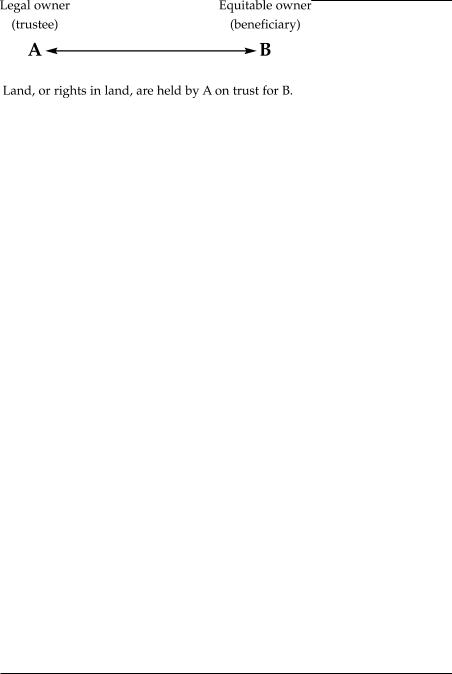
Экзамен зачет учебный год 2023 / Dixon, Modern Land Law
.pdf
Modern Land Law
mortgage against the title of the burdened land; and the entry on the register of the burdened land of legal easements expressly created after 13 October 2003.22
To sum up then: proprietary rights will be legal where they fall within section 1 of the LPA 1925, provided they originate in a deed (with minor exceptions) and so long as they are registered, where such registration is required. This means that even a potential legal estate or interest may fail to be legal because either no deed has been used where required, or a deed has been used but registration has not occurred where required.
1.3.4.2 When is a proprietary right equitable in practice?
A proprietary right has the potential to be ‘equitable’ for one of three reasons:
1Because it is excluded ab initio from the definition of a legal estate or interest found in section 1 of the LPA 1925. Such rights can only ever be equitable because they cannot be legal, as with a life estate, a restrictive covenant, a claim in proprietary estoppel, an option to purchase, a right of pre-emption and so on
2Because despite being within section 1, no deed has been used where such is required
3Where, despite being within section 1 and the use of a deed, registration has not occurred, where required.
However, even if a proprietary right is potentially equitable, that is not enough. Even equitable proprietary rights are required to be created in an appropriate manner before they may exist as such. After all, let us not forget that all proprietary rights – be they legal or equitable – have the capacity to affect land for many years irrespective of who owns it and so we must be reasonably certain that they do in fact exist. In the majority of cases, the relevant formality for the creation of an equitable property right is the use of a written instrument, either a comprehensive written contract signed by, or on behalf of, the parties to the contract as required by section 2 of the Law of Property (Miscellaneous Provisions) Act 1989 or by a written instrument signed by the person creating the equitable right as required by section 53 of the LPA 1925.23 Failing the use of a written instrument, the intended right does not exist at all as a right in property: it is ‘void’ as a proprietary right.24
22Impliedly created easements are not caught by section 27(2), neither are those special easements that fall under the Commons Registration Act 1965 even if expressly created.
23The written contract will be used where the creator of the right receives a benefit in return for burdening his land; a written instrument under section 53 LPA 1925 is more appropriate for a voluntary grant of an equitable right.
24It may be possible to save part of a written instrument by separating a valid clause from an invalid one and giving proprietary effect to the valid part, Murray v. Guinness (1998).
14

Chapter 1: An Introduction to Modern Land Law
However, it may still permit the person to whom the right is given – but only that person – to exercise the right, but the right is then merely personal. It would then be a ‘licence’.
Of course, the requirement of a written contract or instrument for the creation of an equitable proprietary right is relatively formal, but there is a clear distinction between these instruments and a deed, not least that the latter must be witnessed. It does mean, of course, that in the normal case, merely verbal agreements or promises cannot create property rights or obligations. Note, however, that in exceptional circumstances, equity will recognise the existence of an equitable proprietary right arising from an oral contract, agreement or promise, providing the conditions for proprietary estoppel or implied trusts (resulting or constructive) have been fulfilled.25 As will be seen in Chapters 4 and 9 respectively, the creation of equitable rights by purely verbal dealings between the parties is not particularly uncommon, because it serves the needs of fairness – or equity – between the parties. It is an anathema to the law that a person should be able to deny that they have granted a proprietary right to another by pleading non-compliance with statutory formalities if this is their own fault. Nevertheless, the creation of equitable rights by proprietary estoppel or implied trust (i.e. verbally) are in the nature of exceptions to the rule that equitable rights usually should be created in writing, and, consequently, the relevant principles must not be so widely interpreted so as to destroy the basic formality rule itself.26 Finally, for completeness, it should also be noted that property rights arising before the entry into force of the 1989 Law of Property Act27 can be equitable if created by an oral contract without the need to plead proprietary estoppel or constructive trust, provided that that oral contract was supported by some act of part performance in pursuit of the right, as in Thatcher v. Douglas (1996), applying the now repealed section 40 of the LPA 1925.28 This is now of largely historical interest, save that it is possible for professional conveyancers still to encounter a valid equitable right created under the old regime of oral contract plus ‘part performance’.
25By section 53(2) of the LPA 1925 and section 2(5)(c) LPA 1989, implied trusts are a statutory exception to the formality requirements of section 53 of the LPA 1925 and section 2 of the LPA 1989 respectively. Proprietary estoppel is an invention of equity and is justified on a policy basis in order to prevent unconscionability – see Taylor Fashions v. Liverpool Victoria Trustees.
26Auction contracts are also excepted (section 2(5)(b) of the LPA 1989) as are short leases (section 2(5)(a) LPA 1989).
27That is, before 27 September 1989.
28Repealed prospectively by section 2(8) of the LPA 1989.
15

Modern Land Law
1.3.5The proposed system of electronic conveyancing and the distinction between legal and equitable property rights
It may well be that the anticipated introduction of electronic, paperless conveyancing will make the distinction between legal and equitable property rights largely redundant or certainly less significant. By virtue of section 93 of the LRA 2002, the creation or grant of certain specified property rights may be required to be carried out exclusively by means of an electronic entry on the registered title of the estate affected. It will not be the case that such electronic entry is optional, but that without such entry, the alleged property right will not exist at all, even if a paper deed or written contract exists. When this system comes into operation, for those rights specified under section 93, there will be no scope for the distinction between a ‘legal’ and ‘equitable’ version of the rights because deeds and written instruments will be irrelevant. In such cases, the property right will either exist by reason of electronic entry on the register, or it will not.
This system is still some way off, although a pilot scheme has been road tested and some electronic entries connected with mortgages may now be made. However, many things remain uncertain, not least whether the technology exists to make the system a reality. In addition, it is not yet clear whether all property transactions will fall within the realm of e-conveyancing (i.e. be specified under section 93 of the LRA 2002), or just the most fundamental, such as the transfer of freeholds and leaseholds and the grant of mortgages and easements. Neither can we yet know whether the courts will invent a ‘default’ status for rights not created electronically when they should have been, even in the face of an explicit section 93 of the LRA 2002. After all, this is exactly the function of proprietary estoppel in the face of the clear requirements of section 53 of the LPA 1925 and section 2 of the LPA 1989. What we can conclude, however, is that initially some proprietary rights still will be capable of creation by deed or in writing, possibly even with the added choice of electronic registration while we all get used to the brave new world of e-commerce. Presumably in such an eventuality, the old legal/equitable distinction will have some relevance until e-conveyancing becomes mandatory.
1.3.6 The division of ownership and the ‘trust’
Although the distinction between legal and equitable property rights turns, primarily, on the definition in section 1 of the LPA 1925 and the manner in which the right is created, there is a third way by which the distinction can arise. This is where enjoyment of the land is regulated by use of the ‘trust’. In English law and systems derived from it, it is perfectly possible for a single piece of property (any property) to be owned by two or more people at the same time. This is not simply that two people may share ownership; it is,
16

Chapter 1: An Introduction to Modern Land Law
rather, that two or more people may have a different quality of ownership over the same property at the same time. In other words, one person may have the legal title to the property, and another may have the equitable title. Of course, in the normal course of events, when a person owns an estate in land (or any other property), this legal and equitable title is not separated, and the person is regarded simply as ‘the owner’. However, it is the ability to split ownership that is so unique to the English legal system and other common law systems. So, for land, it is possible to have a legal owner and an equitable owner, one with legal rights of ownership, the other with equitable rights. Necessarily, these two owners must stand in a relationship to each other and this relationship is known as a ‘trust’. This is what is meant when it is said that A holds land on trust for B: A is the legal owner (and trustee), and B is the equitable owner (and beneficiary).
Figure 1.3
The trust that exists between A and B can take many forms and different rights and duties can be imposed on A (the trustee) for the benefit of B (the beneficiary) depending on how the trust was established and any relevant statutory provisions (e.g. the Trust of Land and Appointment of Trustees Act 1996 – see Chapter 4). In some circumstances, a trust will be imposed on a landowner without a deliberate act of trust creation, thus creating by force of law a distinction between the legal and equitable titles.29 Finally, it is also important to appreciate that the creation of legal and equitable proprietary rights through the use of a trust requires compliance with a different but complementary set of formality rules to those discussed above; that is, rules similar to (but not identical with) those required for the simple creation of proprietary rights. Unless there is a ‘constructive trust’, ‘resulting trust’,30 or a successful claim of proprietary estoppel, a trust concerning land or any right therein must be ‘manifested and proved by some writing’ as required by section 53(1)(b) of the LPA 1925. This means that the existence of the legal and equitable interests under a trust concerning land depends on the trust
29As with implied, resulting and constructive trusts.
30Both are exempt from formality by section 53(2) of the LPA 1925 and section 2(5)(c) of the LPA 1989.
17

Modern Land Law
being created in the proper manner, although the requirement here is that the trust of land must be evidenced by some written document, rather than actually be in writing itself.
1.4The consequences of the distinction between legal and equitable property rights
It is apparent from the above that whether a proprietary right is legal or equitable may tell us many things; for example, how the right was created and whether there is any possibility of the existence of a trust. However, in times past, one of the most important consequences of the distinction, albeit much modified by statute, was the different way in which legal or equitable rights could affect the new owners or occupiers of the land over which such rights existed. As noted at the outset of this chapter, the peculiar quality of proprietary rights is that they attach to the land, and thus the right to enforce them and the obligation to honour them, is capable of passing to new owners of the benefited or burdened land. This is the situation represented by Figure 1.2. So, for everyday conveyancing, the precise effect of a proprietary right on a third party (in the sense of their obligation to honour it) once depended crucially on whether the proprietary right was ‘legal’ or ‘equitable’. However, while this is not yet a matter of history, it must be appreciated that in modern land law, the effect of a proprietary right on a new owner of land depends much more on the effect and interpretation of statute than it does on the nature of the proprietary right. The impact of the now repealed LRA 1925 was considerable in this regard and this has now been extended and consolidated by the current LRA 2002. Even in respect of that small portion of land that remains unregistered, the relevance of the legal or equitable quality of the right is much reduced by the Land Charges Act 1972. That is not to say, of course, that we must not spend time understanding the distinction, not least because even now it is impossible to understand modern land law without an appreciation of the historical importance and limited present impact of it. Yet we must view the issue in perspective.
1.4.1 Legal property rights before the 1925 legislation
Prior to 1 January 1926, if a proprietary right was legal, it would always bind every person who came to own or occupy the land over which the right existed. As was commonly said, ‘Legal rights bind the whole world’, and the person entitled to enforce the legal proprietary right could exercise it against any purchaser of the land, squatter, donee of a gift and all others. So, for example, the person entitled to a legal right of way (an easement) would have been able to enjoy that right no matter who came to own or occupy the land over which it existed.
18

Chapter 1: An Introduction to Modern Land Law
1.4.2 Equitable property rights before the 1925 legislation
Prior to 1 January 1926, if an existing property right over land was equitable, it would bind every transferee of that land except a bona fide purchaser for value of a legal estate in the land who had no notice of the equitable right. This appears to be a complicated rule, but it can be broken down into its constituent parts. Thus, an existing equitable right over land would be binding on a transferee of that land in all the following cases:
1where the transferee was not a purchaser for value, as where he received the land by will, or as a gift, or under the rules of adverse possession (squatting);
2where the transferee did not purchase a legal estate in the land, as where he occupied the land under an equitable lease;
3where the transferee was not bona fide, as where he acted in bad faith; and
4where the transferee had notice of the equitable right, as where he either knew of its existence (actual notice) or knew of circumstances from which a reasonable person would have been aware of its existence (constructive notice) (Hunt v. Luck (1902), Kingsnorth v. Tizard (1986)), or the transferee’s agent (e.g. his solicitor) had actual or constructive notice (so called imputed notice).
In all these cases, the equitable right would have been binding on a transferee of the land. However, it is important to realise that, in the great majority of cases, the transferee of the land would easily fulfil the first three requirements of the ‘bona fide purchaser’ rule and so could hope to escape being bound by the equitable right by disputing whether or not he had ‘notice’ of the right. In practice, this was usually the only real question. Consequently, the rule about equitable interests became known as the ‘doctrine of notice’, because it was usually the transferee’s ‘notice’ of the equitable interest (bound by it) or lack of notice (not bound by it) that was the live issue. Unfortunately, such were (and are) the vagaries of the doctrine of notice that both the transferee of the land and the owner of the equitable right that was alleged to bind the land could never be sure whether his land or his right (as the case may have been) was secure. In many cases, the ‘owner’ of an equitable right over land could do little to ensure its survival should the burdened land be sold, and, conversely, a purchaser might find that the land they had just purchased was encumbered by an equitable right of which they were deemed to have constructive notice. In short, the operation of the doctrine of notice was so uncertain that the 1925 property legislation modified the rule in a radical way and thereby substantially reduced the importance of the legal/equitable distinction.
19

Modern Land Law
1.5The 1925 property legislation and the Land Registration Act 2002
All that we have considered so far forms the basis of the modern law of real property. However, the start of the twentieth century brought with it fundamental social and economic changes, and when these were allied to the defects, mysteries, vagaries and plain injustices of the law before 1 January 1926, it was clear that wholesale reform was necessary. The detail of the legislative changes that came into effect on 1 January 1926 are considered later in the appropriate chapters, especially Chapters 2, 3 and 4, but for now it is important to realise that both substantive and structural changes were made in 1925, particularly regarding the question of ownership of land and the way in which proprietary rights could affect ‘third parties’, being persons who came to the land after the proprietary right had been created. The main legislative enactments of 1925 are considered briefly below and it should be noted at this early stage that the LRA 2002 has remodelled parts of the original 1925 scheme substantially.
1.5.1 The Law of Property Act 1925
The LPA 1925 made substantive changes to the law of real property, including, as we have seen, a redefinition of what rights could be legal or equitable. It also has much to say about joint ownership of land, the creation of proprietary rights, the nature of the fee simple and leasehold estates, and much more. Although amended in parts, it remains the governing statute for modern land law.
1.5.2 The Settled Land Act 1925
The Settled Land Act 1925 is a complicated statute, designed to regulate the creation and operation of successive interests in land, as where a house is given to A for his life, and then to B. It is considered in Chapter 5. Its importance is much diminished by the abolition of ‘settlements’ for dispositions taking effect on or after 1 January 1997; see section 2 of the Trusts of Land and Appointment of Trustees Act 1996. It would be unusual to come across a settlement governed by the Settled Land Act today.
1.5.3The Land Registration Act 1925 and the Land Registration Act 2002
The machinery originally established by the repealed LRA 1925 and now found in the LRA 2002 is examined in detail in Chapter 2 and this new and comprehensive statute is fundamental to the modern law of real property. It creates a system whereby title to land (being the estates of legal fee simple or
20

Chapter 1: An Introduction to Modern Land Law
legal leasehold) and many other rights in that land are recorded by Her Majesty’s Land Registry in a register held by district offices. In essence, each title is assigned a ‘title number’ linked to a plot of land, under which the ownership of the estate and many other rights affecting the land are recorded. The purpose behind these provisions was – and is – to replace the haphazard system of conveyancing that existed before 1 January 1926 and, especially, to bring certainty and stability to the question of how proprietary rights affect third parties. As such, the LRA 2002 applies to what is loosely called ‘registered land’.
As indicated briefly, the system introduced by the LRA 1925 was ripe for reform and that reform has been made a reality by the LRA 2002. The detail of this will be discussed in Chapter 2 and although most of the central principles of land registration have remained the same under the LRA 2002 as they were under the LRA 1925 (albeit ‘tidied up’ to reflect modern circumstances) there is much that is different. The 2002 Act came into force on 13 October 2003 and the LRA 1925 is no more. Not all of the provisions of the new legislation will take effect immediately (e.g. section 93 and electronic conveyancing), but the LRA 2002 has already affected the way that modern land law operates.
1.5.4 The Land Charges Act 1972
The Land Charges Act 1972 (the LCA, originally, the Land Charges Act 1925) is also examined in detail later (Chapter 3). Once again, it establishes a system to regulate the transfer of land and is also designed to bring certainty to dealings with land affected by the proprietary rights of other people, particularly if those rights are equitable. Importantly, land that is covered by the LCA 1972 is not ‘registered land’ and it falls outside the scope of the LRA 2002. Thus, the LCA 1972 governs what is called ‘unregistered land’, this being land to which the title is not entered on a register but is proved by the title deeds to the property and related bundle of documents.
1.6The distinction between registered and unregistered land
The fundamental distinction which every student and practitioner of property law must draw since 1 January 1926 is between registered and unregistered land. Registered land – more accurately land of registered title – is governed by the LPA 1925, the common law and the LRA 2002. Unregistered land is governed by the LPA 1925, the common law and the LCA 1972. Most importantly of all, registered and unregistered land are mutually exclusive. Land either falls into one system or the other, but never both at the same time. As explained in Chapter 2, the great majority of titles are already
21

Modern Land Law
registered (over 85%) and in due course virtually all land will become registered – a process that has been speeded up by the entry into force of the LRA 2002 – but at present two systems of land conveyancing are in operation in England and Wales side by side. What follows is an outline of the two systems and the detail is provided later in Chapters 2 and 3. Particular attention should be paid to the way in which both systems deal with the question of the effect of proprietary interests on third parties; that is, the issue that was once governed, principally, by the distinction between legal and equitable rights and the doctrine of notice. That said, it is also important to appreciate that ‘registered land’ is the system intended to govern land law into the twenty-first century and beyond and that it is already by far the predominant system. Unregistered land is of diminishing importance.
1.6.1 Registered land
1Registered land is land to which the title is registered in a register. Every title is given a title number and the details of the current owners are registered against it. Once a person is registered as estate owner, that ownership is guaranteed by the State31 and prospective purchasers may buy the land in the certainty that the title has been thoroughly investigated and approved before it was first registered (e.g. as in Habenec v. Harris (1998)). A title that is registered under the LRA 2002 is a strong, marketable title.
2A second category of right in registered land is the registered charge. These are essentially mortgages, used to raise money for the estate owner by offering the land as security for a loan. Mortgages are registered against the estate over which they take effect.
3There is another group of proprietary rights in registered land, central to the operation of the LRA 2002, called unregistered interests which override. These property rights, still conveniently called ‘overriding interests’,32 are automatically binding on any transferee or occupier of the land, without the need for any kind of registration. They have priority over the rights of such transferees, whether the transferee be a purchaser or not.33 Importantly, unregistered interests which override are not only comprised of legal rights, but include a number of equitable rights. This is because they are defined in the LRA 2002 – in Schedules 1 and 3 to the Act – and these definitions are conclusive. In fact, it is a right’s status as an ‘interest which
31Section 58 of the LRA 2002 provides that registration as proprietor of an estate is conclusive.
32As they were known under the LRA 1925.
33Sections 11, 12, 29 and 30 LRA 2002.
22

Chapter 1: An Introduction to Modern Land Law
overrides’ that is important, not its legal or equitable quality, and thus it is the statutory status within the LRA 2002 that makes such rights binding on a third party.
4A fourth category of right in registered land is the protectable registrable interest. These rights include all other proprietary rights not included in the above categories, be they legal or equitable. The fundamental point about these interests is that they will only bind a purchaser of the land if they are registered against the title they affect by means of a Notice.34 If they are not so registered, they have no priority against a purchaser of the affected land, meaning that they cannot be enforced against him.
To conclude, three points about registered land bear repetition. First, in registered land, the effect of a proprietary right on a transferee of the land is determined by its status under the LRA 2002, especially whether it is an interest which overrides or a protectable registrable interest. Its legal or equitable quality is relevant, but not crucial. Second, under the system of the LRA 2002, the ‘doctrine of notice’ is entirely irrelevant, although certain provisions do make reference to the ‘knowledge’ of transferees of land. Third, the concept of overreaching (see Chapters 2 and 4) may allow a purchaser of registered land to defeat certain equitable rights, even if they appear to be technically overriding or their registration has been attempted. So, a purchaser who pays the purchase price of land to the co-owners of a legal estate will ‘overreach’ any equitable owners, meaning that the rights of equitable ownership cannot bind that purchaser, whether or not the rights fall within the definition of overriding interests or are registered protected interests.35 The equitable owner’s rights are, in fact, transferred to the purchase money that has been paid. Overreaching is a limited, but powerful, ‘trump card’ and is explained in greater detail in Chapters 3 and 4.
1.6.2 Unregistered land
Unregistered land is land to which the title is not registered. The title is located in the old-fashioned title deeds, and a prospective purchaser must investigate ‘root of title’ through examination of the title deeds in order to be confident of obtaining an unimpeachable right to the land. Further, in unregistered land, it remains true that ‘legal rights bind the whole world’. This aspect of the pre-1926 common law remains important and an understanding of how ‘legal’ rights come into existence is therefore crucial to understanding
34The Notice is the name given to the register entry. It is not the doctrine of notice.
35In fact, these overreachable equitable shares of ownership cannot be registered by means of a Notice precisely because it is intended that they should be overreached: section 33 of the LRA 2002.
23
